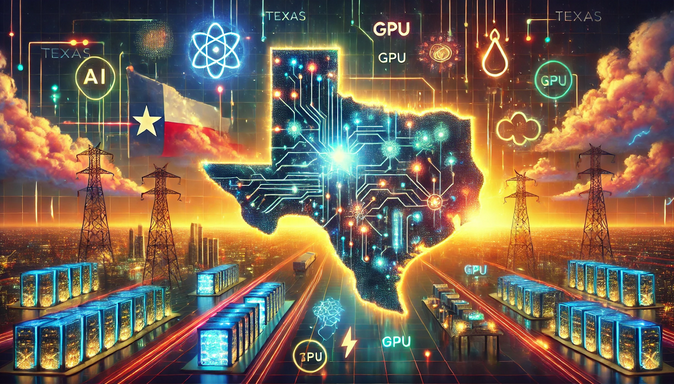(SFTBY), (ORCL), (NVDA), (CEG), (NEE), (MSFT), (VST), (TSM), (AVGO), (GOOG)
At 5 AM, my phone lit up with texts from three hedge fund managers I know, all asking the same thing: "Is this Stargate thing for real?"
Honestly, I wasn’t even surprised. The messages rolled in just a day after Trump unveiled what could be the mother of all tech initiatives: a $500 billion AI infrastructure project dubbed "Stargate," with heavyweights like OpenAI's Sam Altman, SoftBank's (SFTBY) Masayoshi Son, and Oracle's (ORCL) Larry Ellison standing by his side.
But before we get carried away with the headlines, let's look at what really matters to us.
First, some context: The global AI infrastructure market was just $38.1 billion in 2023. That makes this initiative 13 times bigger than the entire current market.
If you're wondering why tech stocks popped on the news, there's your answer.
The semiconductor plays here are particularly compelling. NVIDIA (NVDA) is still trading at under 20X earnings despite 60% growth - a valuation that looks increasingly disconnected from reality given recent developments.
Morgan Stanley's latest channel checks show Blackwell chips are fully sold out for the next 12 months before production even begins, with "several billion dollars" in revenue expected in Q4 FY25 alone.
What's really getting my attention is the GB200 NVL72 system specifications.
It enables up to 72 GPUs to be connected via NVLink, acting as a single GPU with aggregate bandwidth of 259 terabytes per second - about 10 times higher than Hopper.
The implications for data center deployments are staggering.
Speaking of data centers, Oracle has already broken ground on their first Texas facility. It's a million square feet, and they're planning 20 more just like it.
Their stock jumped 8% on the announcement, but here's what most analysts missed: each facility requires approximately 1 gigawatt of power.
This is roughly equivalent to a mid-sized nuclear plant. That's not just a lot of power – that's "Back to the Future" DeLorean levels of energy consumption.
Looking at these numbers made me realize that the energy stocks might just be the sleeper opportunity here.
AI queries consume 3-36 times more energy than traditional searches, and current projections show AI consuming up to 19% of U.S. data center power by 2028.
This creates a compelling case for utilities positioned to serve this growing demand.
Constellation Energy (CEG) stands out in this space. They're already producing about 10% of the nation's emission-free energy, with CO2 emissions 4.5 times lower than NextEra (NEE).
Their recent 20-year Microsoft (MSFT) deal for data center operations is just the beginning. The $840 million government contract they just landed provides exactly the kind of revenue certainty I look for in utility plays.
Vistra Corp (VST) deserves more attention than it's getting. Their dominant position in the Electric Reliability Council of Texas (ERCOT) – where most of these new facilities will be built – puts them in prime position.
The ERCOT market is projected to see 5% annual demand growth through 2030. With their recent $6.8 billion Energy Harbor acquisition, they're now the second-largest nuclear operator in the country.
Meanwhile, Taiwan Semiconductor's (TSM) position here is crucial.
Reports project that we'll need 1.2 to 3.6 million additional wafers by 2030, requiring 3-18 new fabrication plants.
The strategic importance of this manufacturing capacity has already been seen - through Broadcom (AVGO), TSMC has secured manufacturing slots for OpenAI's first custom chip targeting 2026.
This semiconductor build-out is part of a larger global race for AI dominance. OpenAI's recent policy white paper estimates "$175 billion in global funds awaiting investment in AI projects."
Their warning is clear: if these funds don't land in U.S. projects, they'll flow to China-backed initiatives instead.
Now, let's talk about what could go wrong.
The infrastructure constraints are real - Texas's power grid can barely handle summer AC demand as it is.
Water usage for cooling these facilities is another major concern, especially given Texas's history with water scarcity.
We should also consider execution risk.
Trump's track record with big tech announcements is mixed - remember the 2017 Foxconn promise of a $10 billion Wisconsin factory that ended up as a scaled-down $672 million project?
This history of grand announcements versus actual delivery adds weight to current skepticism.
On top of these, Anthropic's CEO Dario Amodei called this plan "a bit chaotic" (tech exec speak for "What are they smoking?"), and Elon Musk took to X to throw shade at SoftBank's funding claims.
Still, the market seems to be ignoring these risks.
When I mentioned them to a tech CEO friend last night, he just shrugged and said "they'll figure it out." Maybe, but I'm watching the ERCOT capacity numbers like a hawk.
And before I forget, keep your eye on Broadcom too.
Their inference chip strategy, led by those Google (GOOG) TPU veterans, could be the dark horse here. While everyone's focused on training chips, the real volume play might be in inference.
For now, I'm holding steady with modest long positions in companies directly benefiting from this infrastructure buildout.
But in Texas, where everything is bigger, so are the opportunities—and the risks. The Volatility Index sitting at $12 tells me it's time to dig deeper.



